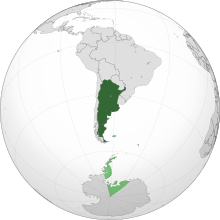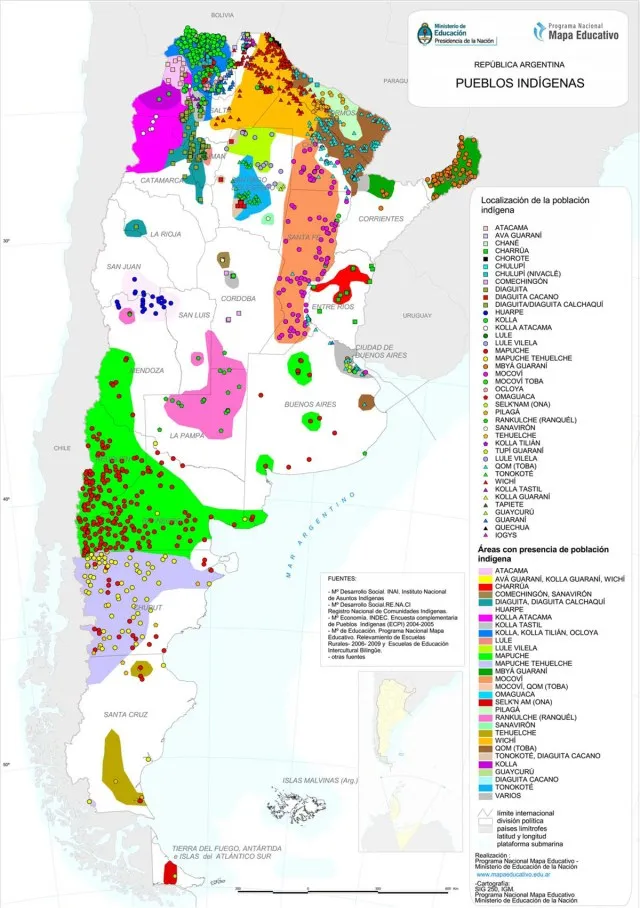More languages
More actions
| Argentine Republic República Argentina | |
|---|---|
 Argentine territory in dark green; claimed but uncontrolled territory in light green. | |
| Capital and largest city | Buenos Aires |
| Official languages | Spanish |
| Dominant mode of production | Neocolonial capitalism |
| Government | Federal presidential republic |
• President | Javier Milei |
• Vice President | Cristina Fernández de Kirchner |
| Population | |
• 2021 estimate | 45,605,826 |
| Currency | Argentine peso |
Argentina, officially the Argentine Republic, is a country in Latin America. It is currently under $44 billion of debt to the IMF.[1]
History
Independence

Argentina declared independence from Spain in 1821. It took a large loan from the British in 1824 and intended to use it to build infrastructure but spent most of it on a war with Brazil instead. The British seized two frigates from Argentina after they defaulted on their loan. Argentina finally finished repaying the loan in 1904.[2] During the early 20th century, the ruling class held its wealth in European banks and favored European currencies over the Argentine peso.[3]
Perón era
Argentina refused to join the neocolonial IMF when it was founded in 1945. Its democratically elected president, Juan Domingo Perón, followed a progressive nationalist program and improved industry through two five-year plans.[2] He bought the British-owned railroads.[3] Pedro Eugenio Aramburu overthrew Perón in a military coup in 1955 and joined the IMF.[2]
Operation Condor
In 1976, as part of Operation Condor, the CIA backed a far-right coup in Argentina that overthrew president Isabel Perón. After the coup, a military junta led by Jorge Rafael Videla took power and killed or disappeared 30,000 left-wing dissidents.[4] Under the junta, Friedmanites from the United States controlled Argentina's central bank.[2] In 1983, military rule ended, and Videla was given a life sentence for crimes against humanity in 1985.[5]
Recent history
Raúl Alfonsín was elected in 1983 following the end of the junta. His presidency ended with a hyperinflation crisis in 1989. He was succeeded by the conservative Carlos Menem. Menem pardoned members of the former junta and reduced taxes and business regulations. By 1990, the inflation rate was 20,000%. He pegged the Argentine peso to the U.S. dollar, oversaw mass privatization, and destroyed the country's extensive rail system.[2]
Between 1999 and 2001, liberal president Fernando de la Rúa continued to implement the IMF's austerity policies. A bank run began in November 2001, and de la Rúa limited withdrawals to $250 per person per week. Riots and a general strike followed, leading de la Rúa to flee the country on 20 December.[2] At the end of 2001, four presidents resigned within two weeks.[6]
Néstor Kirchner became president in 2003. Between 2003 and 2015, Argentina reduced poverty by 71% and extreme poverty by 81% and increased GDP per capita by 42%. Mauricio Macri, who came to power with U.S. support in 2015 and ruled until 2019, took a $57 billion loan from the IMF that led to 140% inflation and a 40% increase in poverty.[6] In February 2022, Argentina joined China's infrastructure program, the Belt and Road Initiative.[7] The areas of cooperation include green energy, technology, education, agriculture, communication, and nuclear energy.[8]
In October 2023, the far-right libertarian Javier Milei was elected as Argentina's president. He seeks to abolish Argentina's central bank and replace its currency with the U.S. dollar.[6]
Economy
Argentina's debt is tied to the U.S. dollar, and it cannot print its own money.[2]
References
- ↑ Ben Norton (2022-12-08). "Judicial coup in Argentina: Corrupt judges conspire with media oligarchs to ban Cristina Kirchner from office" Multipolarista. Archived from the original on 2022-12-09. Retrieved 2022-12-10.
- ↑ 2.0 2.1 2.2 2.3 2.4 2.5 2.6 Esteban Almiron (2022-12-18). "How Argentina has been trapped in neocolonial debt for 200 years: An economic history" Multipolarista. Archived from the original on 2022-12-19. Retrieved 2022-12-20.
- ↑ 3.0 3.1 Vijay Prashad (2008). The Darker Nations: A People's History of the Third World: 'Buenos Aires' (pp. 62–63). [PDF] The New Press. ISBN 9781595583420 [LG]
- ↑ Uki Goñi (2017-04-28). "40 years later, the mothers of Argentina’s 'disappeared' refuse to be silent" The Guardian. Retrieved 2022-01-01.
- ↑ Rosario Gabino (2008-10-10). "Argentina: Videla a la cárcel" BBC. Retrieved 2022-01-01.
- ↑ 6.0 6.1 6.2 Janine Jackson, Mark Weisbrot (2023-11-28). "Milei Is ‘Really as Extreme as You Get in Right-Wing Libertarian Ideas’" FAIR. Archived from the original on 2023-11-29.
- ↑ "Argentina officially joins BRI in major boost for China-Latin America cooperation" (2022-02-06). Global Times. Retrieved 2022-02-08.
- ↑ Benjamin Norton (2022-02-12). "Trapped in IMF debt, Argentina turns to Russia and joins China's Belt & Road" Multipolarista.


